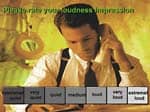|
Despite the fact that continued rapid technological advancements in hearing instruments (both hearing aids and cochlear implants) facilitate improved communicative function for those with hearing impairment, the act of simply fitting hearing instruments cannot and does not completely or efficiently remediate affected communication experiences. When communicative interaction is altered by hearing loss, it impacts the very nature of our beings. It is therefore necessary to reach out to the needs of the whole person when providing hearing health care.
Because communication is transactional in nature, it is necessary to include communication partners in the audiologic rehabilitation (AR) process. Whenever possible, hearing care professionals need to extend their service beyond the individual with the hearing loss, since his/her hearing impairment is not only his/her problem. We can best serve those with whom we work with an approach that integrates audiologic rehabilitation into all that we do.
Such an AR approach is not something we “add-on” to what we do as hearing care professionals; it is the underlying essential component of compassionate care that we provide our patients and their significant others. It is the “golden thread” running through all aspects of the hearing improvement treatment plan. In this sense, audiologic rehabilitation is provided from our very first meeting with the individual (and their significant others) through the entire relationship. In essence, audiologic rehabilitation equals good hearing health care.
The exact content of a rehabilitation program will, by necessity, vary with each individual’s needs. The sidebar on the left includes an appetizing framework for integrating audiologic rehabilitation in all aspects of complete hearing health care. The items listed on the menu as first course and entree are, in our opinion, a necessity for every patient. The items listed as dessert are appropriate for a select number of patients with additional needs.
Following the case history and initial audiologic evaluation, it is important to address not only the degree and type of hearing loss, but also amplification options, the benefits and limitations of amplification, various products available beyond hearing aids (ie, assistive devices), the follow-up fitting and hearing aid checks, training schedules, time commitments, and financial and insurance information. Also critical is information about management and coping skills. Examples include:
- Environmental adjustments;
- Use of communication strategies;
- Assertiveness training;
- Good communication methods speakers and listeners, and
- Additional training options.
Choosing appropriate bibliotherapeutic materials to complement your counseling is a significant help in the process. We have found it is very useful to have different books and handouts available for patients and accompanying parties. These handouts might include communication tips, coping techniques and speechreading strategies. Guidebooks which include appropriate handouts to reinforce your instruction are commercially available.1-6 These materials, which can be duplicated for distribution to patients, are designed for individuals or groups of hearing aid users and their families. Activities and exercises are also included to allow the clinician to select materials appropriate for specific individual learning style, ability and needs. Additionally, many hearing aid manufacturers are providing new educational materials addressing these topics as well.
Family involvement in the rehabilitation process is essential for optimal benefit and improved communication function. Whenever possible, a group session has been found to be an excellent learning opportunity for all participants.7,8 Knowledge of communication strategies and information can enhance the interaction between the patient and their communication partner. Understanding the benefits and limitations of amplification and the acoustic (eg, background noise, reverberation, signal-to-noise ratio, etc) and related factors (eg, speaker-to-listener distance, lighting, etc) of the listening environment can have predictable effects on communication performance.
Even though patients using hearing instruments can be shown to reach real ear targets, there is also a great benefit in demonstrating to them improved word recognition ability, better speech reception thresholds, and improved audibility index scores. With the advent of computerized testing, these measures are easier than ever to generate, and patients are provided with solid, objective evidence of how amplification improves their hearing capabilities.
Guiding patients and their significant others through the adventure of “‘learning how to hear again” is the origin of the audiology profession. Integrating a thorough educational approach into the formula of hearing health care should include audiologic rehabilitation as the common denominator in the equation of providing comprehensive hearing health care.

|
References
1. Wayner DS. The Hearing Aid Handbook: Clinician’s Guide. Washington, DC: Gallaudet University Press; 1990.
2. Wayner DS, Abrahamson JE. Learning to Hear Again: An Audiologic Rehabilitation Guide. Latham, NY: Hear Again; 1996.
3. Wayner DS. Hear What You’ve Been Missing: Coping with Hearing Loss. Minneapolis, MN: John Wiley and Sons; 1998.
4. Wayner DS, Abrahamson JE, Casterton J. Better Communication and Cochlear Implants: A User’s Guide. Latham, NY: Hear Again; 1998.
5. Wayner DS, Abrahamson JE, Casterton J. Better Communication and Cochlear Implants: A Personal Journal. Latham, NY: Hear Again; 1998.
6. Wayner DS, Abrahamson JE. Better Communication and Hearing Aids: A Guide to Hearing Aid Use. Latham, NY: Hear Again; 2000.
7. Abrahamson J. Patient education and peer interaction facilitate hearing aid adjustment. In: Kochkin S, Strom KE, eds. High Performance Hearing Solutions, Vol. 1. Hearing Review. 1997;4(1) [Suppl]:19-22.
8. Ross, M. A Retrospective Look at the Future of Aural Rehabilitation. Jour Acad Rehab Audiol. 1997;30 11-28.
This article was adapted from a presentation at the Intl. Adult Aural Rehabilitation Conference held in Portland, Me, in May 2001. (The Second Intl. Adult Aural Rehabilitation Conference will be held in Portland, Me, on May 5-8. For information, contact Geoff Plant at the Hearing Rehabilitation Foundation: (617) 628-4537.) Correspondence can be addressed to HR or Donna S. Wayner, PhD, Hear Again Inc, 37 Grandview Dr, Latham, NY 12110; [email protected]; Web site: www.hearagainpublishing.com.





